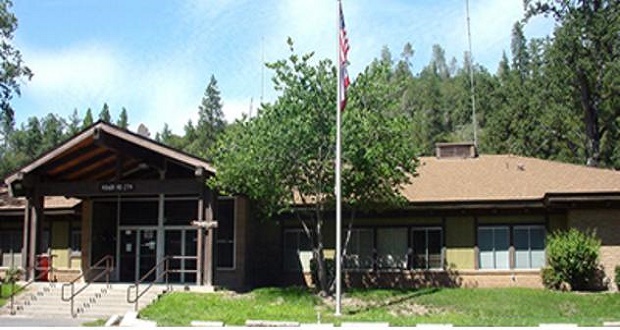BASS LAKE — Testimony continued for the third day in the murder trial of George Taylor-Windsor at Bass Lake Superior Court, as the jury heard from a doctor, a detective, and the couple who got a late-night visit from the defendant.
Taylor-Windsor, 26, is charged with murder in the death of Jessica Nelson, 23, of Foresthill, Calif., and with attempted murder in the stabbing of Reid Kallenberg. The incident took place on Nov. 15, 2016, on Highway 41 just north of Oakhurst, in Kallenberg’s Ford F250 pickup.
On that night, Paul and Kristine Ratchford had just returned to their home on Whoyah Teh after dinner out with friends, and were preparing to turn in for the evening, when they say a loud and insistent banging began on the front door. It was about 10:45 p.m. and both described it as alarming at that hour of the night.
The Ratchford home is located just down the hill from the scene of the stabbings and subsequent vehicle accident.
Mrs. Ratchford was first at the door and turned on the porch light where she saw a man, whom she identified in court as Taylor-Windsor, in a position described as “hunched over, peering through the glass of the front door.”
“Someone’s trying to kill me, let me in!” were the words she heard from the man on the porch.
Her husband was right behind her at the door at this point, and they told the man they would not let him in, but they would call 911.
Mrs. Ratchford said the defendant grabbed the doorknob and jiggled it, trying to gain entry to the house, pleading with them to let him in.
She told her husband to go get the gun and he retrieved it from their bedroom, returned to the front door, and pointed it at the man banging on the door. Once again, they told him to leave and that they had called 911.
Mrs. Ratchford testified that once her husband pointed the gun at the defendant, he turned and walked away at a brisk pace, and headed up the steep embankment on the far side of the driveway, grabbing an old wooden railing as he went and throwing it to the ground. He then disappeared into the dark.
At this point, Mrs. Ratchford said, she went to the front bedroom and looked out the window, and observed a knife laying on the front stoop. She called 911 for a third time to report the presence of the knife on the porch.
Deputy Bianca Zendejas was patrolling the mountain area on the night of the incident. She was in Coarsegold when the dispatch came in for the call on Whoyah Teh and, being mainly a Valley deputy unfamiliar with roads in the Oakhurst area, she found herself at the wrong house.
As she was leaving that address, she said she saw a male subject walking on the gravel driveway. She stopped and made contact with the person she identified in court as Taylor-Windsor, and said that he was asking for help, stating that he had been stabbed with a syringe.
Deputy Zendejas requested EMS respond, and while waiting for the medical personnel to arrive, she lifted up the man’s shirt to look for bleeding or a puncture wound. She told the jury that Taylor-Windsor was lying on the ground at the time and she examined him using her flashlight but found no injuries.
She further testified that after examining the defendant, EMS cleared him medically and determined he was not in need of further assistance. A few minutes later, the deputy placed him in the backseat of her patrol car.
Detective Sergeant Robert Mollet was also called out to the crime scene and arrived shortly after midnight. Initially, the information he was given was that this may have been a minor traffic accident, that there was a deceased person in the vehicle, and another person who was the victim of of assault was en route to the hospital.
He told the jury that when he arrived at the scene it had already been cordoned off as a crime scene and there were deputies posted on the north and south, denying access to everyone. There was yellow tape across the road and he had to check in to be allowed entry. Detective Mollet said he ordered light trailers to illuminate the crime scene and requested a search warrant for the truck.
He then searched the area uphill from the scene for any evidence. At the time of the search, he was aware that there was a fourth person who was not at the scene and was not accounted for. His search included an attempt to locate that person, and any weapons, evidence, or things that would have been of interest to a homicide investigation.
After searching the west side of the highway, Mollet crossed to the east side, went over the guardrail and down the steep slope, searching through the rocky terrain nearly a quarter of a mile down to the river. He said he found nothing out of the ordinary during his search.
Sgt. Mollet also testified to having seen blood spots on the pavement next to the driver’s side door, but that none of his personnel informed him of any other blood stains at the scene, except for the interior of the truck.
After crime scene technicians had documented the evidence and taken photographs, Sgt. Mollet then retrieved Nelson’s body from the truck to arrange for transport to have an autopsy conducted.
The detective testified that the flannel jacket Nelson was wearing was covered with blood and there were marks in the shirt consistent with stab wounds, mostly on the back left side of the shirt. He also noted that, “there was blood everywhere,” inside the truck.
After Nelson’s body had been removed, the truck was towed to the Madera County Sheriff’s facility in Madera, where another crime scene specialist documented and collected all the evidence.
Mollet described for the jury his procedure for ensuring that evidence is not lost, tampered with or compromised, stating that he sealed and secured the zipper on the body bag at the scene with a red zip tie and tag, including the case number and his name. He further testified that, upon arriving at the autopsy, that seal was still intact.
Sgt. Mollet told the jury that Jessica Nelson had two knives on her person, which he observed in the autopsy room. Both were in sheaths, one on either side of her belt. He testified that both knives were in their individual sheaths when they were discovered; that they had not been found somewhere else and then replaced. He also said there was a syringe in her right jacket pocket, and that the cap was in place when the syringe was discovered.
Dr. William Dominic, Director of the Burn Center at Community Regional Medical Center, and surgeon of more than 30 years’ practice, testified about the injuries suffered by Reid Kallenberg.
Under questioning by Deputy District Attorney Paul Hornick, Dr. Dominic described several deep stab wounds, most of them to the right side of Kallenberg’s body.
The doctor testified that Kallenberg was complaining of abdominal and chest pain when he arrived at the hospital, and was having difficulty breathing. He had numerous stab wounds including several to the right arm, one to the abdomen that injured the diaphragm and the liver, and the most serious to the man’s chest.
Dr. Dominici said that stab wound entered at the base of Kallenberg’s neck on the right side, plunged at least three to four inches down into his chest cavity, where it punctured a lung, causing it to collapse and blood to seep into the chest cavity. The force of the blow also fractured a rib. The doctor said he performed two surgeries on Kallenberg.
The last witness of the day testified during a 402 hearing, outside the presence of the jury. Maranda Windsor, ex-wife of the defendant, had been called by the prosecution to describe her rocky relationship and divorce after about two years of marriage to Taylor-Windsor. The hearing was held to allow the judge to hear the proposed testimony, and decide what was relevant and what may be prejudicial.
Maranda Windsor said her divorce was “not pretty,” and that the two didn’t get along due to his alcohol problems.
“He drank a lot,” said Maranda. “When he drank, he usually wasn’t around, and when he was it sometimes got physical.”
She said that Taylor-Windsor wanted to get back together but she didn’t, and during one phone conversation in April 2015, he threatened to kill her. She asked for, and was granted a one-year restraining order.
Maranda also told the court that she still had a good relationship with the defendant’s parents, and that he was allowed to see their son during supervised visitation with them, but didn’t do so very often.
After moving out to California from Casper, Wyo., Taylor-Windsor was trying to “get his life together and clean up his act,” said Maranda, and she had set up an email account so he could write to his son every week.
“He didn’t always do it, but he tried,” she said. Recent conversations had led to frustration on his part, she said, because she is a nursing student and only wanted him to call during set times when she wasn’t studying. He called several times on the night of the fatal stabbing, and she said he was “annoyed, but not disrespectful” when she told him she was busy and would need to call back.
At the conclusion of the hearing, the judge ruled that the testimony about the defendant’s threats, the restraining order, and any acrimony during divorce proceedings was “a bridge too far,” and the prejudicial effect outweighed the probative value.
“I have heard over a thousand divorce cases, and people say things in the heat of the moment,” said Judge Charles Wieland, ruling that the scope of the questions would be narrowed.
To give the attorneys time to reformulate their questions, court was adjourned for the day and will resume at 10 a.m. on Thursday.
Taylor-Windsor has been behind bars since his arrest on Nov. 16, 2016, is being held in the Madera County Jail on a $3.1 million bond. He faces 30 years to life if convicted.




